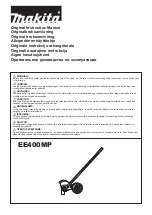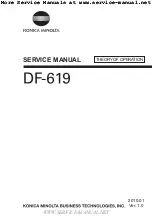
31
Subject to change without notice
chosen is indicated by intensifi ed brightness. Page 1 offers the
memories 1 to 5 and page 2 the memories 6 to 9. The instrument
settings (parameter) are stored in the designated memory by
pressing the function key with the memory cypher.
9.1.2
Recall the actual settings
The function key “Recall” opens the submenu “Front Panel
Recall”. The function key “Page 1 2” is for page selection;
the page chosen is indicated by intensifi ed brightness. Page
1 offers the memories 1 to 5 and page 2 the memories 6 to 9.
The instrument is set to the settings (parameter) recalled from
the designated memory by pressing the function key with the
memory cypher.
9.2 Digital mode
STOP
Attention!
The following functions are not available in connec-
tion with FFT.
The menu options described in 9.1.1 and 9.1.2 are also availab-
le in digital mode. Additionally, the menu options ”Reference
Save“ and ”Reference Display“ will be available. A reference
is a signal which can be stored for later reference to it. 9 non
volatile memory locations are provided.
9.2.1
Reference Save
leads to the following 3 submenus:
9.2.1.1
Source (Reference)
The “Source“ from which the signal - to be stored in a reference
memory - originates can be selected by the INTENS knob.
2
.
9.2.1.2
Destination RE x
There are 9 memory locations available into which reference
signals from the selected source can be stored. Use the INTENS
knob
2
for selection.
9.2.1.3
Save
Pressing ”Save“ will store the signal from the source selected,
into the memory selected.
9.2.2
Reference Display
leads to the following submenus.
STOP
Attention!
Switching on a reference signal display, automati-
cally switches off the display of mathematic signals
and vice versa.
9.2.2.1
RE x, On Off, associated settings
When in this submenu, using the INTENS knob will allow
selection of 2 reference signals which can then be displayed
alongside 2 input signals.
9.2.2.2
RE x
After calling this function the memory location can be selected
with the INTENS knob
2
. (RE 1 to 9)
9.2.2.3
On Off
Control is possible with the on/off pushbutton. When the contents
of the reference memory are displayed, the memory number is
indicated with RE x (x = 1 to 9) at the right hand screen side. Swit-
ching to ”on“ will produce another menu item (”Associa. Set“).
STOP
Please note:
If both reference displays are ”on“ and if both
memory locations are identical (e.g. RE1, RE1) the
signal will be displayed twice on the same spot.
9.2.2.4
Associated settings
Pressing this function key causes the oscilloscope to take over
the settings (parameter) stored when the signal was stored. This
allows you to identify the parameters. Reference signals can also
be determined if the associated settings had not been loaded.
10
SETTINGS
(pushbutton)
Pressing this pushbutton calls the SETTINGS menu. It contains
different submenus in analog and digital mode, which can be
called by the associated function keys.
10.1 Language (Sprache)
In this submenu the language can be selected: English, German,
French and Spanish are available.
10.2 Misc (Miscellaneous)
10.2.1
Contr.Beep On Off
Switches the acoustical signal on or off, which informs about
CW or CCW positions of knobs.
10.2.2
Error Beep On Off
Will turn the acoustical error signal on or off.
10.2.3
Quick Start On Off
In off, the HAMEG logo, the type and the version number will not
be shown, the instrument will be ready immediately.
10.2.4
Menu Off time
The INTENS knob
2
can be used to determine the time in
which the menu is displayed before it is automatically switched
off. Press the MENU OFF pushbutton
43
to switch the menu
display off earlier.
If “Manual“ is selected, the menus can be fi nished or switched
over in the following way:
– Pressing the MENU OFF pushbutton
43
– Pressing another pushbutton
– Pressing the pushbutton that called the current menu dis-
play, taking you one step back in the menu hierarchy.
10.3 Interface
This submenu displays the parameter of the bulit in, changeable
interface. Parameter settings can be changed in the usual way.
Further information can be found in the section “Data transfer“
of this manual, if the original interface is inserted. If an optio-
nal interface is built in, the attached CD contains additional
information.
10.4 Display
This submenu offers several modes of display:
10.4.1
Dots
In this mode the samples are shown as what they are, i.e. dots
(points). This representation is valuable for judging whether
enough samples were gathered in order to sufficiently recon-
struct a signal.
10.4.2
Vectors
In this mode the sampling points are interconnected by drawing
straight lines. If there are only few samples, sin x/x interpolation
is used to ”create“ intermediate points which are then joined
by straight lines.
C o n t r o l s a n d R e a d o u t
















































